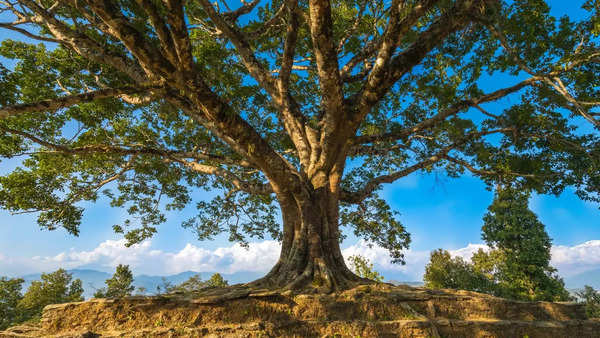
Banyan Tree
There has always been a question of confusion about which one is India’s national tree-the banyan or the Peepal. Both of the trees have very deep roots in the Indian culture, religion, and daily life and they are mostly credited for their specific characteristics that create lots of symbolic meanings. Even though the peepal, with its spiritual flavor and implication of enlightenment, is a tree considered well revered in most Indian traditions, the banyan tree, with its wide canopy and symbolic representations of strength and shelter, has also earned an important place in the lives of the people

Banyan Tree
The Banyan tree: A symbol of eternity
The banyan tree is distinguished by its vast canopy and aerial roots, which grow down from its branches, eventually becoming new trunks. This characteristic allows the banyan tree to cover large areas, providing bigger shade and shelter areas. In many Indian villages, the banyan tree serves as a central gathering place for the community, offering a cool refuge from the harsh sun.
The banyan tree also holds a prominent place in Indian mythology and religion. It is often associated with immortality and wisdom, featuring in various Hindu scriptures and stories. For instance, Lord Krishna is believed to have rested under a banyan tree during his childhood, and the tree is also considered a representation of the divine trinity Brahma, Vishnu, and Shiva.

Peepal Tree
The
Ficus religiosa, or the Peepal tree, is equally important in Indian tradition. It is worshipped as the holy figure among the Hindus and the Buddhists and Jains. According to Indian beliefs, Lord Buddha attaianed enlightenment under the Peepal tree in Bodh Gaya, known as the MahaBodhi Tree.
The Peepal tree also finds mention in ancient Indian texts, such as the Vedas and Upanishads, which describe its importance in spiritual and medicinal life. Having a heart-shaped leaf and a very long life span, it has become known as the tree of eternal life.
So, which is the
Although both the trees hold wonderful cultural and spiritual significance, the banyan tree was selected as the national tree of India because of its widespread symbolism and practicality. The canopy spread and longevity of the banyan tree serves as an excellent symbol of stability and resilience. Its ability to grow and provide shelter over such enormous areas represents the diversity and unity of India, thus making it an excellent idol of the country’s heritage.
A Banyan tree also plays an important role in the Indian village life, as a community centre. It is not just a tree but also a part of the social and cultural fabric of the country.
Conservation and Environmental Impact
Both banyan and Peepal trees have significant roles to play in the surroundings. They offer habitats as well as food to numerous bird, insect, and animal species. The good root systems of the trees stop soil erosion and remain helpful in maintaining water levels underneath, thus maintaining ecological balance.
Such trees help minimise pollution and provide the much-needed green areas in the cities. The Peepal tree is especially known for its environmental benefits, as it even gives out oxygen at night.






